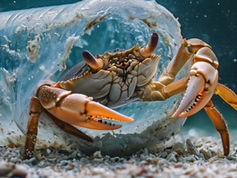Search
Upwelling, Trade Winds, and ENSO
- Lauren A. Moe

- Jul 29, 2024
- 3 min read
To answer the question: “What is an El Niño year, anyway?”, we have to start with the basics of oceanic climate patterns.
Upwelling occurs when cold water from the deep ocean rises to the surface. This process starts with winds blowing surface waters aside, making room for the deeper waters to rise and replace them. When this happens, any organic matter in the deep hitches a ride to the surface as well.
Organic matter is composed of the remains and waste of plants and animals. It is made up of nutrients, such as nitrate and phosphate, which are essential for life. Organic matter is continually falling from the ocean’s lively surface waters, leading to the deep ocean phenomenon of “marine snow”.
This process ensures that deep waters are rich in nutrients, so when upwelling occurs, surface waters are replenished with life-building supplies for the upper water column inhabitants. This leads to highly productive waters in areas of upwelling as nutrients increase the levels of phytoplankton, which feed the small fish, which in turn feed the big fish.
Similar to upwelling, there is a constant cycle of the air around Earth. Warm air from the equator cycles up towards the poles, where it cools and falls back towards the equator. As the Earth spins on its axis, wind moves from the east to the west around the equator. This rotation causes the cycles to curve to the right in the Northern Hemisphere and to the left in the Southern Hemisphere. This pattern forms the Trade Winds, which are responsible for much of the regular upwelling in the Pacific Ocean.

The El Niño and La Niña are extreme, opposing climate patterns that disrupt the normal conditions of trade winds and upwelling, and tend to last around a year. During El Niño years, the trade winds weaken which leads to significantly less upwelling off the Pacific coast. This decreases the abundance of phytoplankton and therefore all other organisms which rely on them. Additionally, since the warmer waters are not being pushed away from the coast, the northern U.S. and Canada experience warmer, drier weather, while the southern U.S. sees wetter weather than usual. This leads to fewer Atlantic hurricanes and more Pacific hurricanes.

Photo Source: NOAA Climate.gov, 2016
In contrast, La Niña years bring in stronger trade winds than normal, increasing upwelling off the Pacific coast and pushing more warm water towards Asia. In North America, weather patterns are opposite from El Niño years. Northern regions are cooler and wetter, while southern regions are warmer and drier. Atlantic hurricanes are also more common, while the Pacific coast experiences fewer than normal.

Photo Source: NOAA Climate.gov, 2016









Thanks for the great explanation!